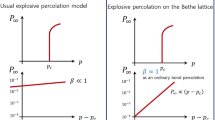Abstract
In the present work we propose a model in which one may vary at will the critical threshold p c of the percolation transition, by probing one candidate site (or bond) at a time. This is realised by implementing an attractive (repulsive) rule when building up the lattice, so that newly added sites are either attracted or repelled by the already existing clusters. We use a tuning parameter k, which is the number of attempts for a site to be occupied, leading to a continuous change of the percolation threshold while the new percolation process still belongs to the same universality class as the ordinary random percolation. We find that by increasing the value of the tuning parameter k, p c decreases until it reaches a minimum value where nucleation effects are now more pronounced than the percolation process. Such results are useful for the explanation of several new experimental systems that have recently appeared.
Similar content being viewed by others
References
D. Stauffer, A. Aharony, Introduction to Percolation Theory (Taylor & Francis, London, 1994)
M. Sahimi, Applications of Percolation Theory (Taylor & Francis, London, 1994)
D. Achlioptas, R.M. D’Souza, J. Spencer, Science 323, 1453 (2009)
N. Bastas, K. Kosmidis, P. Argyrakis, Phys. Rev. E 84, 066112 (2011)
W. Choi, S.H. Yook, Y. Kim, Phys. Rev. E 86, 051126 (2012)
Y. Kim, Y.k. Yun, S.H. Yook, Phys. Rev. E 82, 061105 (2010)
M.E.J. Newman, Phys. Rev. E 64, 016132 (2001)
J.P. Onnela, J. Saramki, J. Hyvnen, G. Szab, D. Lazer, K. Kaski, J. Kertsz, A.L. Barabsi, Proc. Natl. Acad. Sci. 104, 7332 (2007)
H.D. Rozenfeld, L.K. Gallos, H.A. Makse, Eur. Phys. J. B 75, 305 (2010)
T. Bohman, A. Frieze, N. Wormald, Random Structures and Algorithms 25, 432 (2004)
J. Adler, Physica A 171, 453 (1991)
N.A.M. Araújo, P. Grassberger, B. Kahng, K.J. Schrenk, R.M. Ziff, Eur. Phys. J. Special Topics 223, 2307 (2014)
N. Bastas, P. Giazitzidis, M. Maragakis, K. Kosmidis, Physica A 407, 54 (2014)
P. Giazitzidis, P. Argyrakis, Phys. Rev. E 88, 024801 (2013)
J. Nagler, A. Levina, M. Timme, Nat. Phys. 7, 265 (2011)
O. Riordan, L. Warnke, Science 333, 322 (2011)
N.A.M. Araújo, J.S. Andrade, R.M. Ziff, H.J. Herrmann, Phys. Rev. Lett. 106, 095703 (2011)
S. Cho, Y.S. Hwang, J. Herrmann, H.B. Kahng, Science 339, 1185 (2013)
S. Kim, Y.S. Cho, N.A.M. Araújo, B. Kahng, Phys. Rev. E 89, 032113 (2014)
J. Sandler, J. Kirk, I. Kinloch, M. Shaffer, A. Windle, Polymer 44, 5893 (2003)
A. Celzard, E. McRae, C. Deleuze, M. Dufort, G. Furdin, J. Marêché, Phys. Rev. B 53, 6209 (1996)
S. Munson Mcgee, Phys. Rev. B 43, 3331 (1991)
J. Sandler, M. Shaffer, T. Prasse, W. Bauhofer, K. Schulte, A. Windle, Polymer 40, 5967 (1999)
B. Kilbride, J. Coleman, J. Fraysse, P. Fournet, M. Cadek, A. Drury, S. Hutzler, S. Roth, W. Blau, J. Appl. Phys. 92, 4024 (2002)
M.E.J. Newman, R.M. Ziff, Phys. Rev. Lett. 85, 4104 (2000)
N. Bastas, K. Kosmidis, P. Giazitzidis, M. Maragakis, Phys. Rev. E 90, 062101 (2014)
P. Grassberger, C. Christensen, G. Bizhani, S.W. Son, M. Paczuski, Phys. Rev. Lett. 106, 225701 (2011)
R.A. da Costa, S.N. Dorogovtsev, A.V. Goltsev, J.F.F. Mendes, Phys. Rev. E 89, 042148 (2014)
R.A. da Costa, S.N. Dorogovtsev, A.V. Goltsev, J.F.F. Mendes, Phys. Rev. E 90, 022145 (2014)
R.M. Ziff, Phys. Rev. E 82, 051105 (2010)
M. Avrami, J. Chem. Phys. 7, 1103 (1939)
Author information
Authors and Affiliations
Corresponding author
Rights and permissions
About this article
Cite this article
Giazitzidis, P., Avramov, I. & Argyrakis, P. Variation of the critical percolation threshold with the method of preparation of the system. Eur. Phys. J. B 88, 331 (2015). https://doi.org/10.1140/epjb/e2015-60322-0
Received:
Revised:
Published:
DOI: https://doi.org/10.1140/epjb/e2015-60322-0



